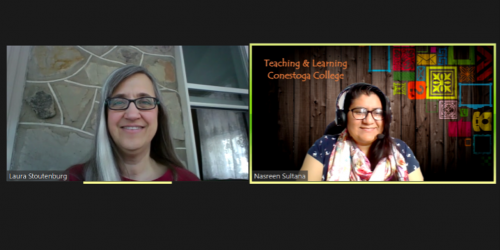Start Your Class with Content-based Icebreakers
Content-based icebreakers are icebreakers are short discussion or active learning activities that incorporate a topic or key concept of the course or class topic. They may be distinguished from get-to-know-you icebreakers, in which students share about themselves and/or discuss topics of interest but that are not directly course related.
Why are content-based icebreakers particularly useful?
- In focusing on the subject matter of the day’s class, they avoid the possibility that the students may have already participated in a similar icebreaker in another class.
- They can provide inherent interest even if the students have been together for several semesters and all know each other. In fact, they can help break up cliques and encourage more diverse partnering.
- They activate prior learning which is a key brain-based tactic (Neumann & Kopcha, 2018; Perselin, et al., 2014)
- They are equally useful at the start of a semester to introduce broad course concepts and at the start of each major unit of learning.
- They can encourage higher order thinking skills related to the content of your course. According to the theory of pedagogical content knowledge, we learn, and thus need to teach, different subjects in unique ways (Bouchard, 2021).
- They stretch your skills in meeting students where they are at in terms of your course.
- They can serve as a pre-assessment or diagnostic which can help you adapt the rest of the class to any gaps or strengths.
- They promote buy-in for students who may otherwise be reluctant or impatient with icebreakers.
- They still encourage community, interaction, and active learning!
What do I need to do?
- Choose a focal point: This can be an image or quote or concept that makes people think about your content area. For example, if you are going to be teaching electrical to brand new, first semester students, you might show a picture of a child about to put a fork into an electrical outlet with a caregiver approaching and have students works in pairs or groups of 3 to discuss 5 things they know about how electricity might operate in this situation. Leave them free to do a web search too.
- Give clear instructions: Describe the goal of the activity and the steps to get there. Whenever possible, “go first” by giving a possible answer or modeling an example. Give a specific time frame and stick to it. Give time reminders, if helpful.
- Debrief effectively: Summarize what was discussed, including the accuracy, range, depth of responses, etc. Ask feedback questions, such as “what was this activity like for you” or “what can we learn from this activity,” or “why do you think it’s important to do an activity like this”?
- Comment on the benefits: Acknowledge what was accomplished in the brief time. How does this activity promote community, energy, hypothesizing, affirmation of what you already know, opening up to curiosity, etc.
- Summarize the learning: Connect the end of the lesson to what information and/or perspectives that the icebreaker activity yielded. If relevant, connect lesson content back to the icebreaker learning.
What are some examples of content-based icebreakers?
- Name a Figure: Identify or name an important figure that has had a significant impact on your field or profession.
- What I See, What it Means: Show a picture and ask students to describe what they see and what it means, etc.
- Not Quite Right: Show an image or tell a story with errors, issues, or problems, then ask students to observe and identify what is not quite right.
- Your Best Guess: Provide a problem, issue, or scenario, and ask students to provide their best guess to address the issue.
- Complete the Sentence: Share a sentence starter prompt and have people complete the sentence: e.g., “Name a strength you have related to this topic.”
- Gallery Walk: Ask a content-related question with multiple possible answers, then give students time to answer as a small group. Once they have documented their responses, have students review how the other groups responded. Alternately, give each group a different response task.
- What is it? If you use, teach with, or train on tools or equipment, put one object in a box (or present a picture of the object on the screen and cover it with a shape). Ask the students to volunteer a Yes or No question to try to determine what the object is. Encourage the students to work together to determine the hidden object in 5 questions. Reveal the object!
Many of these suggestions may be adapted for an online question poll, survey, or discussion forum. Give students a time frame for responses, then share and respond to them the following week!
What else should I consider?
- Keep the icebreaker positive and interesting, but also simple and low stakes.
- Keep it short: timebox the icebreaker so it does not overlap with other lesson deliverables.
- Give alternative ways to participate (especially if your class is online).
- Encourage students to focus on the activity and minimize distractions in their vicinity.
- Keep participation voluntary and avoid judgement of students who do not or under participate — encouraging attendance and participation at any level will help build a safe, trusting environment.
- Acknowledge that even icebreakers can yield differences in perspectives, opinions, and speaking that can be surprising. Give students ways to share when there may be an issue with what was said or done. For example, ask that students say the word “ouch” to indicate they may have been unintentionally offended, and “oops” if they believe they may have accidentally offended (CUNY, n.d.).
- Avoid repeating the icebreaker, but consider doing a variation of a similar ice breaker in a later class. This enables students to be more familiar with the structure of the icebreaker and what is expected.
- Have fun with content-based icebreakers to make learning a good experience!
References
Bouchard, J. (2021). Pedagogical Content Knowledge. Salem Press Encyclopedia.
CUNY. (n.d.) Icebreakers and Interactive Activities 5.b. https://www.cuny.edu/wp-content/uploads/sites/4/media-assets/CCF-ClassroomSupportsCareerPathway-Icebreakers.pdf
Neumann, K. L., & Kopcha, T. J. (2018). The Use of Schema Theory in Learning, Design, and Technology. TechTrends: Linking Research & Practice to Improve Learning, 62(5), 429–431. https://doi-org.conestoga.idm.oclc.org/10.1007/s11528-018-0319-0
Persellin, D. C., & Daniels, M. B. (2014). A concise guide to improving student learning : Six evidence-based principles and how to apply them. Stylus Publishing.



